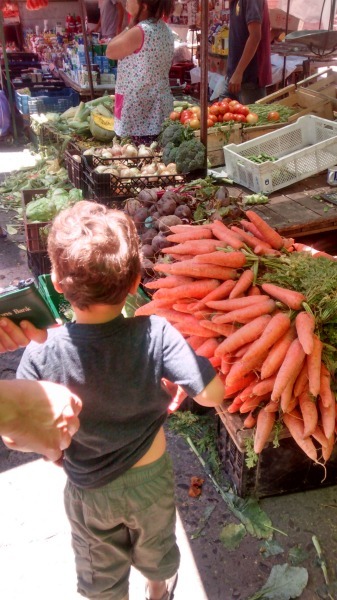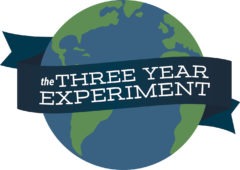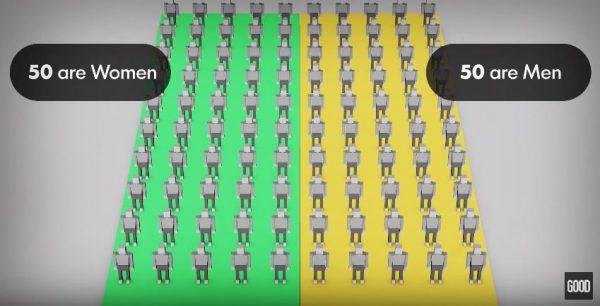I’ve been thinking a lot about the dumb luck of being born in one of the world’s wealthiest countries. It reminded me of this post, which is one of my favorites. Every once in a while, I find it really helpful to go drone-like and fly up above my privileged circumstances to reflect on how fortunate I and my family really are. Videos like the one below help me to take a few minutes to put things in perspective.
Last night, my son asked me to replay a video I’d shown him last year. It’s called If the World Were 100 People. Maybe you’ve seen it. One of my professors in my Master’s course introduced me to the video last Spring.
If you’ve got two and a half minutes, it’s a great watch.
The company that developed the video, GOOD Magazine, used research from the Central Intelligence Agency’s World Factbook to give us an idea of what our world would look like if its almost 7.5 billion inhabitants were reduced to a mere 100 people. 100 is a number we can wrap our brains around fairly easily. We all know 100 people. We’re probably friends with 100 people.

The video shows the statistics of our world’s gender, religion, language, economics, and age, spread out over 100 people.
Some statistics really put my Americas-centric worldview to test. I learned that there are more people in Africa than in North and South America combined. The Americas, combined, would contribute 14 to our world population of 100. Africa would contribute 15. Asia would contribute 60–more than half. More than the Americas, Africa, and Europe combined.
When Mr. ThreeYear and I visited Southeast Asia in 2016, we got a small sense of this reality. There was an entire continent of people living their lives, a vast swath of the Earth, that we had never visited, never experienced. Most had never visited my continent and never would. There was a whole world, or half a world, at least, that I had been entirely oblivious of until that point, that was entirely oblivious of me.

The Financial Part
Since this is a Personal Finance blog and I am a Personal Finance nerd, I was most struck by the economic data in the video. It breaks down our world’s daily earnings. The worst–15 people of 100–make less than $2 per day. While that is a sobering statistic, it is one that has improved over the last decade. Bill and Melinda Gates have highlighted the gains the Gates Foundation and others have made in combating extreme poverty in their Annual Letters (here’s the 2017 letter).
56 people, more than half, make between $2 and $10 per day. This is a vast difference in income, though. $730 and $3650 are very different sums to live on. But, wow. More than half of the people in the world live on, in one year, a tiny fraction of what many in the developed world live on in a month.
Only 6 people of 100 make between $50 and $90 per day. That is $18,250-$32,850 per year or $1520-$2737 per month.
And ONE person of 100 makes more than $90 per day. That same person controls 50% of the wealth in our world.
One person. $33,000 a year. 50% of all the world’s wealth.
Do you feel a little richer now?
Only one percent of the entire world makes more than $33,000 per year.
Does that shock you? It does me. The vast majority of the people I know make more than $33,000 per year in the US. A first year teacher’s salary is around $42,000 in my school district, for a frame of reference.
I don’t know about you, but I certainly don’t feel rich most of the time. But for most of the readers of this blog, we’re not just rich, we’re uber rich. We are the 1%.
Weforum explains further using net worth, rather than income, statistics:
The Global Wealth Report 2015 highlights another unexpected fact: that the world’s wealthiest 1% is not entirely made up of billionaires, but contains a significant number of people whose assets amount to $759,900 or over. Indeed, there are only 123,000 ultra high net worth individuals (defined as those whose assets exceed $50 million) worldwide. As a group, however, they lay claim to 45% of the world’s wealth.
They explain that a full 71% of the world’s population have assets that amount to less than $10,000 (so if you have debt, you’re not alone).
If you have around $100,000 in assets, count yourself among the top 21% of the world.
If you have anywhere between $100,000 to $1 million, you’re in the top 7.4% of the world, and if you have a net worth of over $1 million, you are in the top .7% of the world and are among the group that controls 45.2% of the world’s wealth.
For me, statistics like this help me do a reset. They give me a sense of place in this grand world. It is inconceivably vast and we are small. Our lives don’t feel small, of course. We get wrapped up in our day-to-day routines and lose all kinds of perspective (my alarm clock didn’t go off and I can’t fit in a morning run! Arghh!). It can be easy to compare yourself to only those who are in your immediate vicinity. If you’re saving a large portion of your income, like we’re trying to do, it’s also easy to become discouraged. It often feels like we can’t do everything we want with the money we have, because we choose to spend so much on our future.
However, when we look at just how good we actually have it, it’s flat-out humbling. It also makes it easier to stand by our frugal ways, in my opinion.

There’s a great section in The Poisonwood Bible, the classic novel by Barbara Kingsolver about a missionary family who raised their daughters in Africa, in which Leah, the middle daughter, moves back to the US for grad school with her African husband and lives on a small grant. She and her husband Anatole are constantly shocked by the abundance of America. The other students find it difficult to live on the small amount of money they have, but Leah and Anatole find their lifestyle lavish. They have their own apartment, for just the two of them. With electric appliances. And a huge variety of food in endless supply. Because they have the perspective of having lived in the developing nation of Angola for years, they’re able to see the incredible abundance in front of them for what it is.
Ok, let me step down from my soapbox, here, because I certainly don’t feel like we live in a pool of incredible abundance all the time. I’m not constantly caressing my microwave or dishwasher and I’m not marveling that I have clean tap water anytime I want (but when you really think about it, how luxurious). But, when I take a moment to remember that I have food, shelter, transportation, health care, and money to spare! then my FOMO urges dissipate a bit.
Because let’s be honest–it can be challenging to be frugal. Sometimes it feels like we’re the only ones who don’t buy new cars every two years (I know we aren’t but it can feel like it!). But when we reset and realize that our frugal lifestyle is considered outright lavish living by most of the rest of the world, then anything other than careful spending feels, honestly, wasteful.
We believe traveling to other parts of the world where people have different standards of living, and actually experiencing those ways of life, is a great way for us to help our kids with this reset. My husband grew up in a developing country and I spent years living in one (and visiting others) so for us it’s now less of a shock to see how little it takes to live happily in many parts of the world. But our kids have a different worldview. They have only lived in an economically prosperous area with little diversity. So we feel it’s imperative for them to see how privileged our lives really are.

We work to feel grateful for our beautiful lives, and also help others where we can. I hope our location independence opens up the possibility of showing our kids the big, beautiful, diverse world so that we can nurture frugal, careful, kind, and compassionate citizens of the world.
What about you? How do these statistics make you feel?



I don’t generally pay attention to these kinds of statistics. Sure, it’s nice to know that the average American needs to earn around $300k a year to be in the 1%. But what does that tell me? Not much really, besides the fact that I need to work harder to make more money 🙂
This is true, but to be in the global top 1%, you only need to earn one tenth of that amount. I think it just puts our American drive for more, more, more into perspective. Most Americans are already in the top 1% with their starting salaries. 🙂
What this video tells me is all in the broadening of my perspective. I know what it feels like to be an American with an income above the average but I really cannot fathom living on $2.00 a day. Trying to imagine life through another’s eyes really makes me appreciate what I have even more.
Thanks for your comment! 🙂 I agree 100%. The things we take for granted every day like shelter and running water, would be luxuries for a lot of people in the world. It makes me grateful and makes me want to be more careful with what I have!
This is a very interesting post. We lose perspective so easily of that we have – and therefore, take it for granted-, and concentrate on what we don’t. It’s a good reminder for us to think about our end goal: is it just have more $$, things, bigger house, nicer cars? Or is it, independence and financial freedom – not to just seat on the couch, but to really really go after what we value the most (friends, family, travel) in my case.
You and I see eye-to-eye! Yes, I agree–studies have shown that it’s really relationships and experiences that bring us the most long-term happiness. I’d rather use my scarce resources to do things that bring me long term joy and have independence and freedom, versus keep up with the Joneses!
i can relate to it ,after born in india and living there ,when i was growing up my dad income per month was 3000 rupees/70 dollars.Family of 6 survived on it and he sent us all to school.Here $70 /month wouldnt take you anywhere.
Wow. That is a truly amazing story. No, here, $70 wouldn’t buy one person a month of food unless they had a big garden to feed themselves.
I think Desi points it out well above, it’s relative purchasing power that actually counts when you compare disparate geographies.
That’s an excellent point, Buck. I would add that not only is it relative purchasing power, but it’s societal norms as well. What do we define as a poor, middle-class, and rich lifestyle in our respective countries? I certainly don’t feel rich because everyone around me has a similar lifestyle, but when I take a step back and realize that the items that I have in my middle class home would be considered absolute luxuries in other countries, then I can put some of the mad consumerist drive to have “more, more” into its proper perspective.
I am always amazed at how rich even the poorest individual in the US is. When you look around the world and see people who do not have running water or are working for $1 a day it is quite humbling. Thanks for sharing this info!
I feel the same way! It really hit home when I lived in Chile, and realized there was no unemployment if you lost your job. No social safety net meant…hunger, if you didn’t have any relatives or friends to help you out. Although I will say I read a great book last year called “$2 a Day: Living on Almost Nothing in America,” (www.twodollarsaday.com) that opened my eyes to how some people in the US live, who receive federal assistance but essentially have no cash. And it is not pretty, either. Poverty pretty much stinks, wherever it occurs.
Those stats are interesting, but they don’t tell the whole story. First, they “they only earn $x ” is a little deceiving because most of them don’t earn any dollars; rather they earn lira, rupees, etc. The value of their currency against the dollar is important if they are buying or selling American goods, but it has little to do with their lifestyle.
Secondly, even if they did get paid in dollars, the cost of living is far lower in many places–and so is the standard of living, I’ll admit. Here, you couldn’t put the whole family in a 400 sq ft apartment that shares a bath with the family down the hall if you wanted to. In some countries that is middle class housing–it has indoor plumbing, electricty etc. and the family has disposeable income.
I have a friend from Honduras. Her husband had what we would consider a middle-class job. Kids were in private schools, some money for travel, owned their own home and had a fulltime maid/nanny. Still, the electricty went off for a few hours every day and when she came to US to shop, she bought at Kmart, not Saks.
You bring up very good points, RAnn. I think it’s heartening to realize that $10US a day goes farther in many countries (or currencies) than it would in developed nations like the US or Sweden. It always surprises me, in Latin America, especially, what is available for very little $ and what isn’t, no matter the cost. I’ve been to Honduras, and was shocked that things that we take for granted in the US, like paved roads, don’t exist for anyone regardless of class. In Chile, where my husband is from, the cost of service providers (like nannies/housekeepers) and handymen is far lower than in the US, but other goods, like electronics, are super expensive. I think it’s telling for Americans that immigrants can come to this country and live on $10K per year. I heard many stories of immigrants living 10 to an apartment (in Atlanta), eating rice and beans, and sending almost everything home to their families. When your frame of reference is changed, “necessities” like personal space become luxuries.
Wow, I do try to remind myself that any little daily struggles I may have are minor #firstworldproblems and that we are fortunate in life but these numbers give me a whole new frame of reference. I know we are well off compared to the average American but compared to others in the world being in the top 1% is certainly humbling. Thank you for sharing.
Thanks for dropping by Mrs. Simply! I agree–I find these statistics humbling. Anytime I’m tempted to complain I’m going to rewatch the video! 🙂
These are pretty staggering statistics, although I’ve heard others say that the top 1% make over 250K. That might just be in the US, however.
You’re completely right about not feeling appropriately grateful for the abundance we have here in the US. It’s kinda nuts really. I have also done a lot of travel in 3rd world countries and I’m amazed at how happy people can be with relatively little.
As for me, I don’t need much in the way of things, but I like my creature comforts. The one thing that always got to me about being in third world countries was the lack of climate control, personal space, hot showers, and comfortable beds. If I can have those things, I’m a happy camper.
Thanks for the reminder of how lucky I am. It helped me put some rather insignificant issues in perspective. Very helpful.
Thanks for stopping by, Caren! Yep, I think the global 1% skews the average quite a bit from our American high of six figures. I’m 100% with you on hot showers and comfy beds, by the way! This video gives me perspective every time I watch it.
Hmm, I think statistic can be a bit misleading.. It makes no sense to compare wages only. You earn 50.000 USD per year but pay 1000 USD per month rent.. I earn 20.000 USD per year in Slovenia but only pay 200 USD rent in a second largest city.. Could be lower if I move to other place or a bit higher if I move to capital city.. We have almost free healthcare, free schools. A friend of mine moved to Switzerland and earns 5.000 EUR a month, but pays 1.500 EUR rent for an apartment.. People that earn 10 USD per day do not pay 1.000 USD rent. A glass of beer costs 10 EUR in Swizerland but 1.5 EUR in Slovenia.. I have 120.000 EUR saved from my 9 years of work, where most Americans have nothing saved with wages 5-10x higher than mine (I earn 1.300 EUR per month..) Sure we/you can buy more stuff then most other people, but just comparing wages without the cost of living, cost of travel, cost of food, health care etc does not say that much. This is why it only makes sense if you can earn american wage working remotely from Thailand as more and more people do. High pay, low cost of living = win! 🙂
And one last example, I just read somewhere that average Cuban earns like 20 EUR per month?!?! But they have their food paid (food cards), almost free gas, paid health insurance, paid education. They earn almost nothing, but if you want to have the same standard of living in US, you would have to earn like 15.000 USD a year or even more considering health costs and educations… See the point? That is why a lot of people in US earning low wages are almost starving and living a lot worse than someone earning 1/10 of that in some undeveloped country..
Tomaz, you make some excellent points here! As you and other commenters have pointed out, cost of living is a key piece to this topic, and I know there are a lot of bloggers who focus on low cost-of-living areas in the US and worldwide in order to maximize their retirement dollars. Like you said, high pay, low cost of living = win! It would be interesting to see if these statistics could be recalibrated with a real cost-of-living index thrown in so we could compare apples to apples. Even so, I think that the idea of this video is to give someone living in a developed country some much-needed perspective on how much we truly have, even if the purchasing power of our dollars isn’t equivalent.
I discovered extreme early retirement blogs earlier in the year, and as someone who grew up in Spain and now lives in the UK, I have to do say that it does strike me how conspicuously rich most people writing about FIRE/ERE are. I know, some are at the end of their journey so that makes sense, but even those who are starting out… It’s a given that everyone has somewhere to live, a car, materials good seem to flow.. Growing up in Spain wasn’t quite like your husbands upbringing in Chile which you mentioned in another post, but certainly there wasn’t a culture of credit either. If you wanted a car, you saved up for it.
It feels interesting sometimes to be in this in-between space, and it helps to notice things. However, your stats highlight how well off even someone in Spain is compared to someone in large parts of the world. The running water, hot water, and shelter are themes that recur in that we take them for granted and we can instead try to be grateful for them.
PS recently found your blog and loving it. Thanks for writing!
Thanks so much, Maria! I really appreciate your kind words. Yes, I agree with you that a lot of the people in the FIRE space are quite well off (even if we don’t all realize it!). I think it has to do with Maslow’s Hierarchy of Needs–until your basic needs of food, shelter, transportation are met, you aren’t really thinking about early retirement, you’re thinking about how to make it day-to-day. Once you’ve got the basics met, and a little extra, you’re more likely to think about how to save and invest (and blog about it!). I think we FIREs also have a tendency to be “rat racers,” that is, always thinking about the next goal and the next achievement. But then we miss the bounty that we already have in front of us. I definitely agree that gratitude can help to counteract that rampant dissatisfaction. I lived in Madrid in college and I noticed that the family I lived with was very careful with food, money, possessions, more like Chile than the US, for sure. (And I love your country!!).